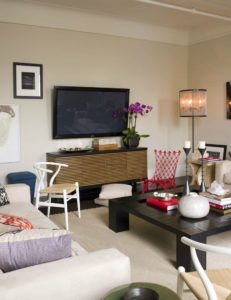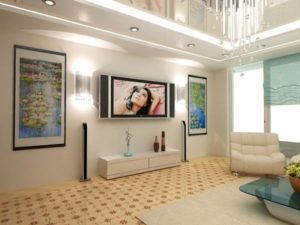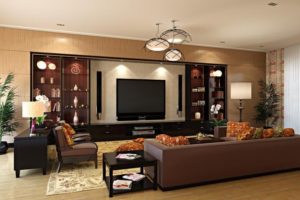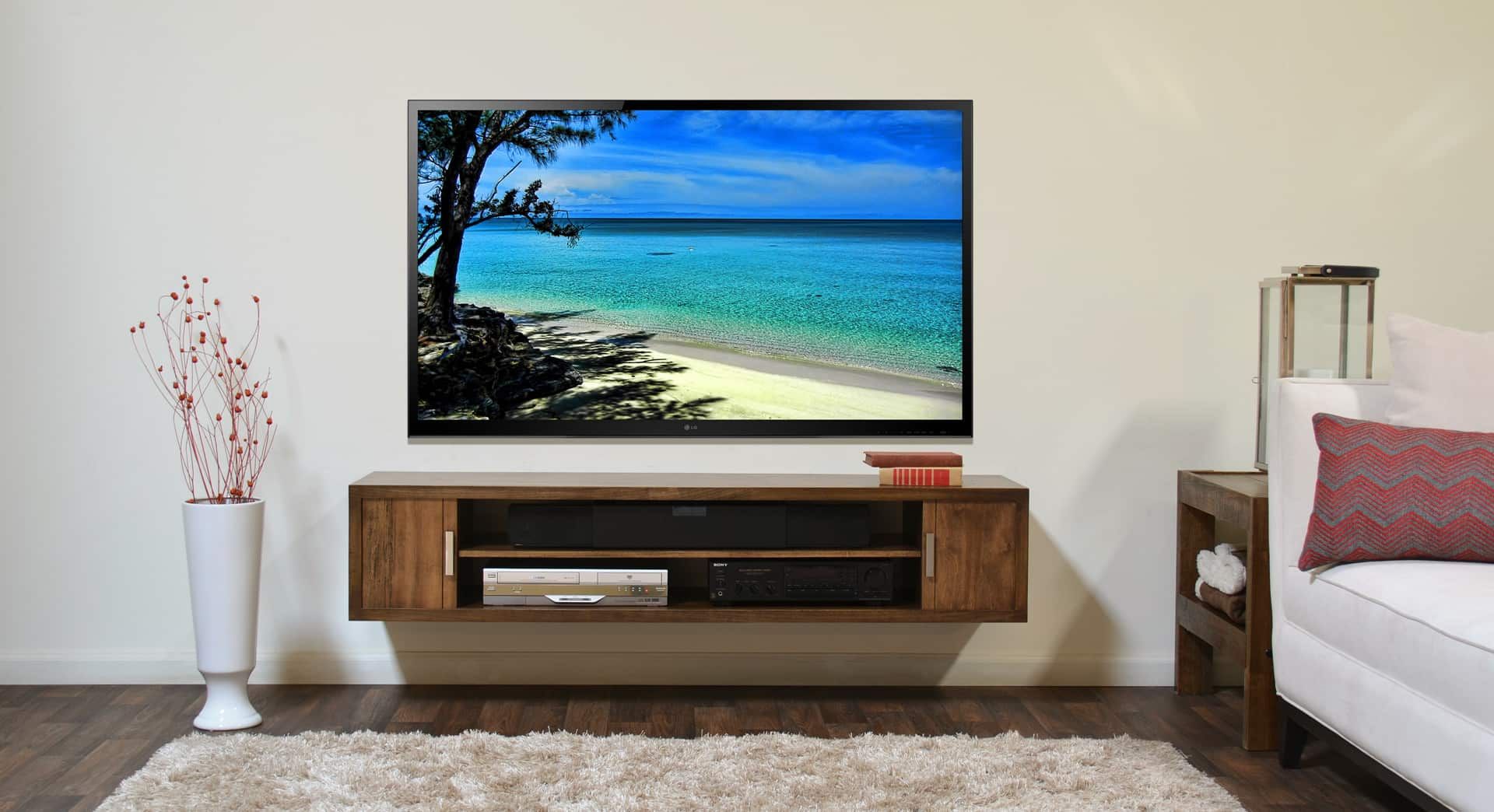TV in the living room interior, photo
A living room can be comfortable and attractive even without a TV. However, this item is necessary when, due to tradition, it brings together a family circle or guests at home. Task number one is to install the screen so that viewing is comfortable. The second is to fit it correctly into the interior so that it does not visually discord with other objects. This is especially important for the classical style and trends close to it.
The content of the article
Rules for placing TV in the living room
 For people who are ready to turn their living room into a home theater, the issue of placing a TV is solved as simply as possible. One wall becomes a place for a large screen, and the opposite wall has comfortable sofas and armchairs, low tables. What could be better?
For people who are ready to turn their living room into a home theater, the issue of placing a TV is solved as simply as possible. One wall becomes a place for a large screen, and the opposite wall has comfortable sofas and armchairs, low tables. What could be better?
If the living room is also intended for other activities: playing music, chatting near the fireplace, games or reading, then it is important to avoid disharmony between the objects in this room. What matters is the style, color, size and correct placement of all interior details, including the TV.
The simplest rules when installing a TV:
- it is optimal to look at it not half-turned, but straight;
- it should be at eye level;
- the distance to the screen depends on its size, this ensures viewing comfort;
- the screen should not be exposed to natural light;
- There are no objects placed near it that could damage the technical device (mechanical impact and overheating are excluded).
Taking these requirements into account, it is worth considering all the interior details. The TV, due to its functional features, will dictate the arrangement of other items. Such a dictate is not always liked by designers who want to give the room originality in accordance with the chosen style, and they try to disguise the equipment - cover it with doors, curtains, and so on. But even in these cases, the screen in the room has to be taken into account: the placement of other things in the living room will depend on its location, otherwise viewing will become impossible.
How to decorate a TV wall in the living room
 If the interior of a living room with a TV serves for different purposes, and not just for watching movies and other media products, then designers offer several interior solutions, which can be roughly reduced to two areas:
If the interior of a living room with a TV serves for different purposes, and not just for watching movies and other media products, then designers offer several interior solutions, which can be roughly reduced to two areas:
- divide living room areas using decor;
- decorate the wall for the TV, taking into account its external characteristics and size.
A wall decorated with a TV does not so much draw attention to it as emphasize the zoning of the room. This can be achieved in a variety of ways - painting the wall in an alternative color, special wallpaper, artificial stone, panels, etc.
One of the best traditional options is to install a chest of drawers, a cabinet, or a shelf under the TV in the living room interior, the photo of which you see above (even attached to the wall). No less familiar and convenient is to place shelves above and around it or to build a screen into a closet specially made for the living room, taking into account the video equipment located in it.Books, albums, vases, and souvenirs are placed on such shelves and cabinets. The screen looks quite natural among them, without becoming a boring accent.
If the wall above the TV stand remains too empty, then select paintings, posters, photographs in frames, the color of which is in harmony with the interior.
Placing TV in classic and modern living room interiors
 If the interior is strictly consistent in one of the recognized stylistic directions, then special attention to all details is inevitable, from the architectural features of the room to the accessories and souvenirs in the room. This applies to any equipment located indoors.
If the interior is strictly consistent in one of the recognized stylistic directions, then special attention to all details is inevitable, from the architectural features of the room to the accessories and souvenirs in the room. This applies to any equipment located indoors.
Sometimes designers try to put the TV “out of sight” so as not to spoil the overall composition. More often this need arises in classic interiors. It is much easier to link the screen with modern interiors, especially with minimalism or high-tech style.
The classical style in its most general sense refers to Baroque, Rococo, and Classicism. There are columns, arches, and exquisite furniture decoration. How to avoid dissonance between such a simple object as a TV and the uniqueness of stucco, a set in the style of Louis XIV, expensive vases reminiscent of ancient Greek or Chinese counterparts?
If you don’t hide the TV in a special niche, or disguise it in a closet or behind a drapery, then finding an adequate design solution becomes a bit of a puzzle. It is complicated by the fact that often a fireplace is included in the interior of a classic living room. These two objects are considered dominant in the room, and therefore, in a certain sense, contradictory. Two centers are not only illogical, but also inconvenient.Therefore, the room must be zoned for different types of activities.
However, real professionals manage to find a solution in this case: a not too large artificial fireplace, placed in the same plane with a screen of the same size, looks quite harmonious. Although a small fireplace is a compromise with respect to the classics.
In any case, they try to remove everything related to technology - wires, sockets, etc., and choose the TV frame in a color that is in harmony with the color of the furniture set and walls.
Eclecticism, hi-tech or laconic style in the interior are more lenient towards the TV screen; they are almost the same age. Therefore, it is much easier to fit a “black square”, or rather a rectangle, into dark, light or shiny metal surfaces in modern interiors. They are not overloaded with details, and the functionality of the TV is quite compatible with the general style of such rooms. Including Scandinavian design. However, for this style, zoning and decorating the wall under the screen are good ideas.





